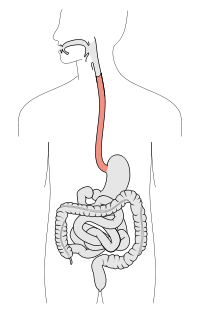
Photo from wikipedia
A 53-year-old man was referred to the endoscopy unit for evaluation of noncardiac chest pain. He did not report dysphagia, gastroesophageal reflux disease symptoms, or weight loss. His medical record… Click to show full abstract
A 53-year-old man was referred to the endoscopy unit for evaluation of noncardiac chest pain. He did not report dysphagia, gastroesophageal reflux disease symptoms, or weight loss. His medical record included hyperlipidemia and duodenal peptic ulcer disease along with a history of smoking (20 pack-years). Upper endoscopy showed a long segment of columnar-type epithelium extending from the top of the gastric folds (35 cm from incisors) (▶Fig. 1 a) to the cervical esophagus (20 cm), corresponding to C15M15 (Prague classification) Barrett’s esophagus (BE). The distal and middle part of the BE segment was inconspicuous both in white-light and narrow-band imaging (▶Fig. 1b). However, at the top of the Barrett's metaplasia, just below the upper esophageal sphincter, a protruded ulcerated tumor was identified (▶Fig. 1 c, ▶Video 1). Tumor biopsies confirmed a well-differentiated adenocarcinoma on a background of intestinal metaplasia. Positron emission tomography-computed tomography scan showed a marked increase inmetabolic activity in the cervical esophagus without evidence of metastatic spread (▶Fig. 1d). Although squamous cell carcinoma (SCC) accounts for nearly 90% of esophageal cancers worldwide, the incidence of esophageal adenocarcinoma (EAC) has already surpassed that of SCC in several regions of North America and Europe [1]. Similarly to its precursor condition, BE, EAC is typically located in the distal esophagus where inflammation from gastric acid reflux is most profound. Carcinoma of the cervical esophagus is rare (2%–10%) and nearly all of these tumors are SCC in origin (~95%) [2]. Reports of adenocarcinomas in this region are confined to cases arising within inlet patches [3, 4], rather than BE. While neoplastic changes preferentially occur in the proximal parts of BE segments [5], the extension of Barrett’smetaplasia rarely reaches the cervical esophagus. The optimal management of such tumors is not established; however, surgery remains the mainstay treatment for adenocarcinoma. In our case, a multidisciplinary decision for pharyngo-laryngo-esophagectomy with neoadjuvant chemoradiotherapy was taken.
Journal Title: Endoscopy
Year Published: 2020
Link to full text (if available)
Share on Social Media: Sign Up to like & get
recommendations!